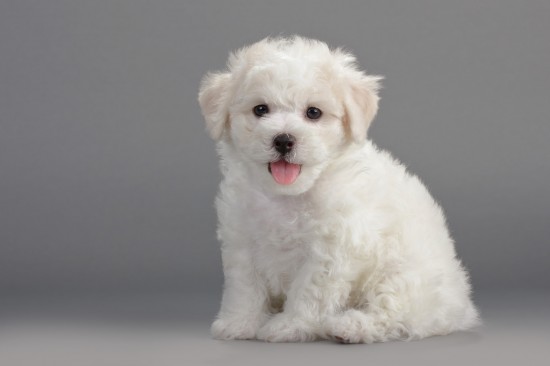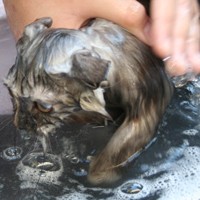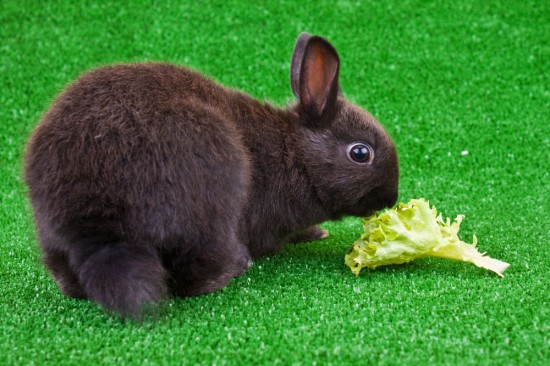
There are three breeds of dogs that stem from the high mountain regions of Tibet. The Tibetan Terrier, the Tibetan Spaniel and the Tibetan Mastiff. All three are indigenous to the region and were known to be in existence as long as 1000 years ago. The Himalayan regions of Tibet encompass high cold mountains and hot deserts and grassy flat plateaus. The dogs that developed are hardy and adaptable because of the harsh regions in which they originated. The people of Tibet are wanderers and nomadic in nature. they did not purposely breed dogs. Thus the Tibetan Terrier, known for being of compact size, possessing double coat and great agility and large flat feet, suitable for crossing the rugged terrain, is a true creature which demonstrates “survival of the fittest”.
The Tibetan Terrier’s coat may be of any color, but it is always long and profuse and double. Thorough brushing down to the skin at least twice a week helps to keep it looking nice, though in the wild lands of Tibet it is true that it does not bother the dog when it is unkempt and uncombed! The coat should not be shaved, for mother nature has endowed it with insulation in both hot and cold weather and also protection from the sun. A dog whose coat is shaved is much more likely to develop skin problems and irritations. The coat of the Tibetan Terrier parts naturally down the middle of the back and if kept clean and free of mats it is an easy job to comb out, but once mats have developed this can be quite a chore. Attention needs to be paid to the ears also, which are long and covered with long hair, if they become infected they are difficult to keep clean because no air gets to the inside of the ear.
Other than coat care and occasionally a nail trim, there is not much else which needs to concern an owner of a Tibetan Terrier, as they seem to have a natural good health and are not prone to a lot of the diseases which afflict many of the modern dogs. There can occasionally be found cases of juvenile cataracts or hip dysplasia but for the most part the incidence of these problems is low.
Oddly enough, the Tibetan Terrier is not truly a “Terrier” and does not qualify except in the area of being of small stature. This dog furthermore is not shown in the Terrier classes. In the United Kingdom he is classified as a “Utility Dog” and in the United States the classification is that of the Non-Sporting group. Terriers are known to be rodent killers and “ratters” and this is the farthest thing from the description of the capabilities and usefulness of this breed.
Through the years of its development, the Tibetan Terrier and the Nomadic tribes began to interact and the dogs became part of the livelihood of the Tibetan people, serving as a drover of the flock, a companion and a caravan dog. Eventually this dog became an indispensable part of the life of the monasteries, the small villages and the wandering tribes. The small size (15-16 inches at the shoulder) and the hardiness of the coat and sturdiness of its’ structure have become important attributes in the performance of these various tasks. Furthermore, the Tibetan Terrier has become an indispensable part of the family life of its’ owners and masters, preferring human company above all else and likewise being treasured and loved by the people to whom it belongs.
The Tibetan Terrier in the modern family of today makes a gentle and sensible companion, a wonderful obedience dog and also excels in the sport of agility. It is an intelligent dog, loves to learn tricks and delights in pleasing its owner.
Michael Russell
Your Independent guide to Animals
 The Best Low-shedding Dog Breeds For Families
The Best Low-shed
The Best Low-shedding Dog Breeds For Families
The Best Low-shed
 Love Me, Love My Dog - Introducing A New Partner Into Your Dog’s Home
Love Me, Love My
Love Me, Love My Dog - Introducing A New Partner Into Your Dog’s Home
Love Me, Love My
 How To Get Rid Of Fleas On Kittens
If you are seeing fleas on your kitten, its very importa
How To Get Rid Of Fleas On Kittens
If you are seeing fleas on your kitten, its very importa
 Cat Genetics Part One - What Is A Gene?
Cat Genetics Part
Cat Genetics Part One - What Is A Gene?
Cat Genetics Part
 Diet Requirements And Feeding Of Rabbits
Diet Requirements
Diet Requirements And Feeding Of Rabbits
Diet Requirements
Copyright © 2005-2016 Pet Information All Rights Reserved
Contact us: www162date@outlook.com